While we see another year off, ANN would like to use this space
to pay tribute to those in aerospace and aviation who will not be
among us as we welcome in the New Year.

Some left us far too early; others lived long, healthy lives.
But whatever the individual circumstances, we honor these folks for
their courage, contributions, and prescience in the field of
aerospace that bonds us all...
2 July: USAF General Howell M. Estes
Jr. -- From July 1964 until he retired in August 1969,
Estes was commander of the Military Air Transport Service, later
known as the Military Airlift Command, during the Vietnam War. In
addition to his responsibilities of supporting US forces fighting
communism in the jungles of Southeast Asia, he had oversight of a
global military airlift system, now known as Air Mobility Command,
to include aeromedical evacuation operations, air rescue, air
weather, photography and mapping services throughout the world.
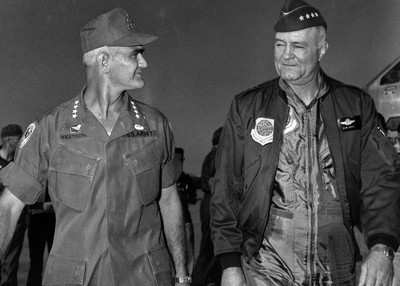
13 July: WWII Ace Cook
Cleland -- Born in Cleveland, OH, in December 1916,
Cleland joined the Navy in 1940 -- taking his flight training at
Lambert Field in Missouri, qualifying as a dive bomber pilot in
Pensacola, FL. During WWII, Cleland was assigned to the USS
Lexington flying a Douglas SBD Dauntless. After the war, Cleland
came home and bought an airport, the former Euclid Avenue Airport
in Willoughby, OH. He rechristened it Cook Cleland's Euclid Avenue
Airport and opened the FBO offering flight lessons, air charter and
banner towing. He later achieved his dream of winning the Thompson
Trophy in the Cleveland National Air Races -- twice, in 1947 and
1949.
7 August: KTLA Anchor Hal
Fishman -- A mainstay in Los Angeles-area television
news for nearly 50 years, Fishman was also well-known in the
southern California aviation community, and throughout the world.
He shared in 12 airspeed and altitude world records, serving as
crewmember onboard various jets flown by Clay Lacy. He also
reported news stories from the cockpit of his personal aircraft.
Interviewed by filmmaker Brian Terwilliger for the aviation
documentary "One Six Right," Fishman described how aviation called
to him at a young age. "As a little kid, just stand with my hands
up against that fence [at Van Nuys Airport], looking out and
watching the planes... and nagging my mother to let me go up in an
airplane," Fishman recounted.
24 August: Bill Piper, Jr. --
Son of Piper Aircraft founder William Thomas Piper, Sr. and an
accomplished aviator in his own right, Bill Piper Jr. learned to
fly while working in his father's aircraft plant. He was a
record-breaking pilot, and was one of the last acknowledged flying
daredevils of the 1930s. Later in life, Piper Jr. headed up one of
the most successful aircraft manufacturing companies in the nation,
that boasted revenues in the hundreds of millions of dollars. He
was also a founding boardmember of the General Aviation
Manufacturers Association (GAMA) in 1970, and was named Chairman of
the organization three years later.
28 August: Dr. Paul MacCready
-- The designer of the human-powered "Gossamer Condor," MacCready
was also an internationally renowned, Caltech-trained scientist,
innovator and entrepreneur, as well as founder and former chairman
of the board of directors of AeroVironment, Inc. His passing
occurred less than one week after the 30th anniversary of one of
his most notable accomplishments -- the record-setting flight of
the Gossamer Condor, that won MacCready the Kremer Prize. He
also designed and built a follow-up airplane, the Gossamer
Albatross, which completed a successful crossing of the English
Channel on June 12, 1979 -- winning the second Kremer prize in the
process. Led by MacCready, AeroVironment later built the Gossamer
Penguin, a 3/4 scale variant of the Albatross that utilized solar
panels mounted above the wing to power the one-seat aircraft's
small electric motor.
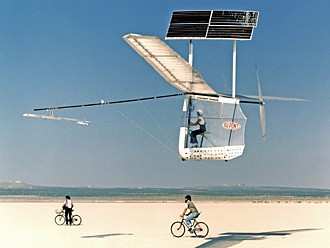
22 September: Josephine "Fifi" O'Connor
Agather -- Namesake of the Commemorative Air Force's
(CAF) B-29 FIFI. In the 1960s, Victor Agather spearheaded the drive
to add a B-29 to the CAF's fleet and then successfully worked to
remove the "no-fly" clause in the original agreement with the Air
Force. As a result, in 1974 the aircraft was named FIFI in honor of
Agather's wife. The only remaining airworthy B-29 in the world,
FIFI is currently on display at CAF International Headquarters in
Midland, TX.
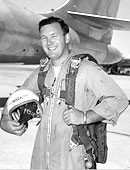 1 October: Former DFRC Director Stanley
Paul Butchart -- Butchart flew a number of prototype
aircraft at Edwards in the 1950s, as well as the B-29 motherships
used to launch experimental X-1A aircraft. During one such test
launch of an unmanned X-1A, Butchart was credited with jettisoning
the attached rocketplane moments before it exploded -- saving his
crew and aircraft. He earned the NACA Exceptional Service Medal
after the incident. In 1951, Butchart joined the National Advisory
Committee for Aeronautics' High-Speed Flight Research Station --
the facility that later became NASA Dryden. He became Dryden's
chief test pilot in 1966; he retired from DFRC 10 years later, as
director of flight operations.
1 October: Former DFRC Director Stanley
Paul Butchart -- Butchart flew a number of prototype
aircraft at Edwards in the 1950s, as well as the B-29 motherships
used to launch experimental X-1A aircraft. During one such test
launch of an unmanned X-1A, Butchart was credited with jettisoning
the attached rocketplane moments before it exploded -- saving his
crew and aircraft. He earned the NACA Exceptional Service Medal
after the incident. In 1951, Butchart joined the National Advisory
Committee for Aeronautics' High-Speed Flight Research Station --
the facility that later became NASA Dryden. He became Dryden's
chief test pilot in 1966; he retired from DFRC 10 years later, as
director of flight operations.
7 October: Doolittle Raider Maj. Nolan
Herndon -- Herndon’s plane and crew have been a
controversial mystery in the years since the raid on April 18,
1942. Unlike the others which crashed in China, Herndon -- who was
a navigator, bombardier and gunner -- and his pilot and co-pilot
headed instead for the Soviet Union, supposedly an ally of the US.
The Soviets, who had maintained diplomatic relations with Japan to
that point, had refused a US request for all the planes to land
there. Herndon maintained the other two men on his plane were
last-minute substitutions, intelligence agents intentionally
diverted in a test of the Soviets' resolve as allies of the US. The
three men were imprisoned after they landed, but escaped after a
year. For his valor, Herndon received the Distinguished Flying
Cross.
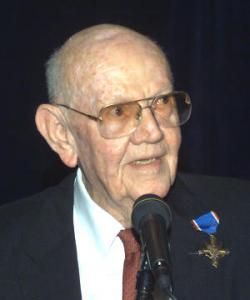 11 October: Flying Tiger David Lee 'Tex'
Hill -- Hill graduated as a naval aviator in 1939...
and soon joined the battle brewing overseas. He joined the American
Volunteer Group "Flying Tigers" in China in 1941, flying Curtiss
P-40 Warhawks. Hill's accomplishments in the AVG were forever
immortalized in the 1942 film, "The Flying Tigers" -- with John
Wayne playing him on the silver screen. After dissolution of the
Flying Tigers in 1942, Hill was one of only five Flying Tigers to
join its USAAF successor, the 23rd Fighter Group. He later rose to
command the Group, as a major in the US Army Air Corps.Throughout
the war, he racked up 18 1/4 confirmed enemy kills. He emerged from
the war a hero, with numerous medals -- including a Silver Star,
Legion of Merit, the British Flying Cross, and six Chinese combat
medals. In 2002, he earned the Distinguished Flying Cross.
11 October: Flying Tiger David Lee 'Tex'
Hill -- Hill graduated as a naval aviator in 1939...
and soon joined the battle brewing overseas. He joined the American
Volunteer Group "Flying Tigers" in China in 1941, flying Curtiss
P-40 Warhawks. Hill's accomplishments in the AVG were forever
immortalized in the 1942 film, "The Flying Tigers" -- with John
Wayne playing him on the silver screen. After dissolution of the
Flying Tigers in 1942, Hill was one of only five Flying Tigers to
join its USAAF successor, the 23rd Fighter Group. He later rose to
command the Group, as a major in the US Army Air Corps.Throughout
the war, he racked up 18 1/4 confirmed enemy kills. He emerged from
the war a hero, with numerous medals -- including a Silver Star,
Legion of Merit, the British Flying Cross, and six Chinese combat
medals. In 2002, he earned the Distinguished Flying Cross.
1 November: 'Enola Gay' Pilot Paul
Tibbets -- It was one moment in time, that brought
about an end to war... the annihilation of a city, and a large
portion of its population... and both fame and infamy to Paul
Warfield Tibbets, Jr. The dropping of the first atomic bomb on
Hiroshima, Japan on August 6, 1945 changed the world forever -- and
left Tibbets, who flew the B-29 Superfortress "Enola Gay" that
dropped that bomb, with no regrets. To the very end, Tibbets had to
ward off protestors who criticized him for his role in the
destruction of a city, and the loss of between 70,000 and 100,000
people. Per his own request, Tibbets had no funeral... and no
headstone, so as not to give protestors a place to gather.
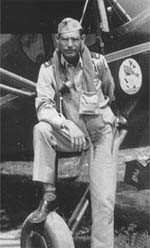 9 November: CAP Colonel Henry Ed
Phipps -- A lifelong spokesman for Civil Air Patrol
anti-subchaser patrols, Phipps joined CAP on the first day the
organization was formed on December 1, 1941. A member of the
Maryland Wing, he flew subchaser missions out of Coastal Patrol
Base 2 in Rehoboth Beach, DE. Phipps was the featured anti-sub
veteran in the History Channel’s segment on CAP
anti-subchasers that aired in November 2001. Thiel said Phipps
organized reunions for Coastal Patrol Base 2 for more than 20
years, in addition to his work as a spokesman. At the time of his
death, Phipps was one of the few living members of Coastal Patrol
Base 2, which was based in Rehoboth Beach, DE during World War
II.
9 November: CAP Colonel Henry Ed
Phipps -- A lifelong spokesman for Civil Air Patrol
anti-subchaser patrols, Phipps joined CAP on the first day the
organization was formed on December 1, 1941. A member of the
Maryland Wing, he flew subchaser missions out of Coastal Patrol
Base 2 in Rehoboth Beach, DE. Phipps was the featured anti-sub
veteran in the History Channel’s segment on CAP
anti-subchasers that aired in November 2001. Thiel said Phipps
organized reunions for Coastal Patrol Base 2 for more than 20
years, in addition to his work as a spokesman. At the time of his
death, Phipps was one of the few living members of Coastal Patrol
Base 2, which was based in Rehoboth Beach, DE during World War
II.
14 November: Fred 'Crash'
Blechman -- His buddies called him "Crash" -- the
funny ex-Navy pilot who earned his nickname by crashing five F4U
Corsair fighter planes on landing during training missions at the
end of World War II. Shortly before his death, Blechman refused
surgery to repair an aneurysm doctors said could take his life at
any time. He thanked them, but instead of treatment returned to the
home he shared with his wife, Ev, who died six months earlier.
22 November: Colonel Jefferson DeBlanc,
Sr. -- DeBlanc earned the Medal of Honor, the US
military’s highest honor for bravery, for actions during an
air raid against the Japanese in the Solomon Islands on January 31,
1943. The young lieutenant in his early twenties was the leader of
six planes that provided air cover. Flying an F4F Grumman Wildcat,
he downed two Japanese float planes and one fighter before
returning for the naval base at Henderson Field. He then spotted
two Japanese planes climbing up behind the bombers.His entire group
was low on fuel, so Henderson ordered the rest of his flight
squadron to return. He personally took on and shot down the two
enemy aircraft, knowing he would likely not have enough fuel to
return safely. The F4F was shot up and DeBlanc parachuted into the
ocean, where he swam all night to reach Kolombarangara Island.
Henderson was then captured by local natives... and traded to
another tribe for rice. He was later picked up by a Navy float
plane and returned to his squadron.
30 November: 'Rocket Man' Evel
Knievel -- Though admittedly known more for his daring
motorcycle stunts than his piloting skill, one can't deny the
storied daredevil stunt man also racked up his share of time in the
air... albeit only a few seconds at a time, and more often than not
followed by a hard landing. In the end, it wasn't one of his stunts
that cost Evel Knievel his life... but, in a sense, all of them.
Riddled with scars from his many attempted daredevil feats,
Knievel's health had failed him for years. He also suffered from
diabetes and pulmonary fibrosis, an incurable condition that
scarred his lungs. Knievel underwent a liver transplant in 1999
after nearly dying of hepatitis C -- which he believed he
contracted through a blood transfusion from an earlier injury. He
also suffered two strokes in recent years. Knievel was best known
for a failed attempt to jump an Idaho canyon on a rocket-cycle and
a stunning crash at Caesar's Palace in Las, Vegas, NV. He is even
immortalized at the Smithsonian Institution as "America's Legendary
Daredevil."
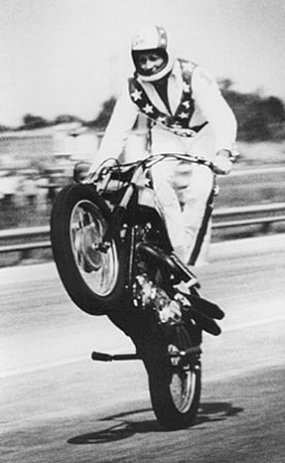
14 December: Palm Springs Air Museum
Founder Robert Pond -- A former naval aviator, who
later founded the Palm Springs Air Museum to honor World War II
airmen, Pond said he first fell in love with airplanes at age 10...
and, eight years later, told a Navy recruiter he'd be forced to
take radical action if they didn't admit him to the Navy Air Corps
program in 1942 (he threatened to join the Army instead.) After the
war, Pond graduated from the University of Minnesota, and bought a
Cessna 180. Over the years, Pond built collections of both warbirds
and vintage cars. He opened the Palm Springs Air Museum on
Veteran's Day in 1996. Pond was also well-known in sporting
circles, as the namesake of the Pond Racer, designed by Burt Rutan
and Scaled Composites. Pond commissioned the design in the late
1980s, to compete alongside vintage warbirds in the Unlimited Class
at the Reno air races. The all-composite twin-engine aircraft paid
homage to the Lockheed P-38.
 Aero-News: Quote of the Day (12.07.25)
Aero-News: Quote of the Day (12.07.25) ANN's Daily Aero-Linx (12.07.25)
ANN's Daily Aero-Linx (12.07.25) NTSB Final Report: Lafferty Jack Sea Rey
NTSB Final Report: Lafferty Jack Sea Rey Classic Aero-TV: The B29 SuperFortress Doc - History in Flight
Classic Aero-TV: The B29 SuperFortress Doc - History in Flight Airborne 12.08.25: Samaritans Purse Hijack, FAA Med Relief, China Rocket Fail
Airborne 12.08.25: Samaritans Purse Hijack, FAA Med Relief, China Rocket Fail









